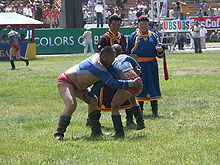- Naadam
-
Naadam (Mongolian: Наадам, lit. "games") is a traditional type of festival in Mongolia. The festival is also locally termed "eriin gurvan naadam" (эрийн гурван наадам) "the three games of men". The games are Mongolian wrestling, horse racing and archery and are held throughout the country during the midsummer holidays. Women have started participating in the archery and girls in the horse-racing games, but not in Mongolian wrestling.
In 2010, Naadam was inscribed on the Representative List of the Intangible Cultural Heritage of Humanity of UNESCO.
Contents
Overview
The biggest festival (Naadam of the Country) is held in the Mongolian capital Ulaanbaatar during the National Holiday from July 11 – 13, in the National Sports Stadium. Other cities and towns across Mongolia and those with significant Mongolian populations in China, have their own, smaller scale Naadam celebrations. It begins with an elaborate introduction ceremony featuring dancers, athletes, horse riders, and musicians. After the ceremony, the competitions begin.
Naadam is the most widely watched festival among Mongols, and is believed to have existed for centuries in one fashion or another. Naadam has its origin in the activities, such as military parades and sporting competitions such as archery, horse riding and wrestling, that followed the celebration of various occasions. Now it formally commemorates the 1921 revolution when Mongolia declared itself a free country.
Another popular Naadam activity is the playing of games using shagai, sheep anklebones that serve as game pieces and tokens of both divination and friendship. In the larger Nadaam festivals, tournaments may take place in a separate venue.
The three games
Wrestling
Main article: Mongolian wrestling512 or 1024 wrestlers meet in a single-elimination tournament that lasts nine or ten rounds. Mongolian traditional wrestling is an untimed competition in which wrestlers lose if they touch the ground. When picking pairs, the wrestler with the greatest fame has the privilege to choose his own opponent. Wrestlers wear two-piece costumes consisting of a tight shoulder vest (zodog) and shorts (shuudag). Only men are allowed to play.
Each wrestler has an "encourager" called a zasuul. The zasuul sings a song of praise for the winning wrestler after rounds 3, 5, and 7. Winners of the 7th or 8th stage (depending on whether the competition features 512 or 1024 wrestlers) earn the title of zaan, "elephant". The winner of the 9th or 10th stage, is called arslan, "lion".[1] In the final competition, all the "zasuuls" drop in the wake of each wrestler as they take steps toward each other. Two time arslans are called the champions, or the "avraga".[1]
Horse racing
 Riders in Mongolia during Naadam festival.
Riders in Mongolia during Naadam festival.
Unlike Western horse racing, which consists of short sprints generally not much longer than 2 km, Mongolian horse racing as featured in Naadam is a cross-country event, with races 15–30 km long. The length of each race is determined by age class. For example, two-year-old horses race for ten miles and seven-year-olds for seventeen miles. Up to 1000 horses from any part of Mongolia can be chosen to participate. Race horses are fed a special diet.
Children from 5 to 13 are chosen as jockeys who train in the months preceding the races. While jockeys are an important component, the main purpose of the races is to test the skill of the horses. [2]
Before the races begin, the audience sings traditional songs and the jockeys sing a song called Gingo. Prizes are awarded to horses and jockeys. The top five horses in each class earn the title of airgiyn tav and the top three are given gold, silver, and bronze medals. Also the winning jockey is praised with the title of tumny ekh or leader of ten thousand. The horse that finishes last in the Daaga race (two-year-old horses race) is called bayan khodood (meaning "full stomach"). And a song is sung to the Bayan khodood wishing him luck to be next years winners. [3]
See also: Mongol horse
Archery
Mongolian archery is unique for having not only one target, but hundreds of beadrs or surs on a huge wall. In this competition both men and women participate. It is played by ten-men/women teams who are given four arrows each; the team has to hit 33 "surs". Men fire their arrows from 75 meters away while women fire theirs from 65 meters away. When the archer hits the target the judge says uuhai which means "hooray". The winners of the contest are granted the titles of "national marksman" and "national markswoman".
See also: Mongol bow
See also
- Tsagaan Sar (English "White Month"), the Mongolian Lunar New Year (the first most important Mongolian holiday before Naadam).
References
- ^ a b "The Maulers of Mongolia", Black Belt magazine, July 1969, p. 22
- ^ "Naadam Festival." The Center for the Study . 16 Apr 2008 <http://www.csen.org/Mongol.Nadaam/Mongol.text.html
- ^ "Naadam Festival." The Center for the Study . 16 Apr 2008 <http://www.csen.org/Mongol.Nadaam/Mongol.text.html
External links
- Chinggis Khaan's Mongolia. S. Uranbileg and E. Amarbilig. Ulaanbaatar, 2006, 156 p. ISBN 99929-6-508-8. In English.
- Naadam Festival - The Center for the Study of Eurasian Nomads
- Mongolia's Manly Sports - Ron Gluckman
- Naadam Festival Package Tours - Naadam Festival
- Analysis of the three sports of Naadam
- Article about Naadam
- Audio coverage of horse racing
Categories:- Multi-sport events
- Festivals in Mongolia
- Tuvan culture
- Secular holidays
- Cultural festivals
- July observances
- Sport in Mongolia
- Winter traditions
- National days
Wikimedia Foundation. 2010.




